Panasonic TZ202: Lens
Lens Characteristics in Short | A Few Technical Data | Some Quotations from Lens Reviews | My Own Two Cents... | References
On this page, I would like to discuss one the specific characteristics that lead me to buy the Panasonic TZ202, namely the lens. I investigate what the available test results and the reviewers say, and I also offer links to camera reviews.
Lens Characteristics in Short
The Panasonic TZ202 features a fixed Leica DC Vario-Elmar 8.8-132 mm (24-360 mm equiv.) f/3.3-f/6.4 lens with a zoom range of 15 x. Thus, it offers the equivalence of about a dozen "classic" prime lenses between 24 mm and 360 mm. Zoom is set using the zoom lever or using the control ring around the lens. Manual distance is set using the control ring. There are no marks on the lens, and the camera regrettably lacks distance and depth of field indicators on the LCD screen (only a coarse distance scale is shown when focusing manually).
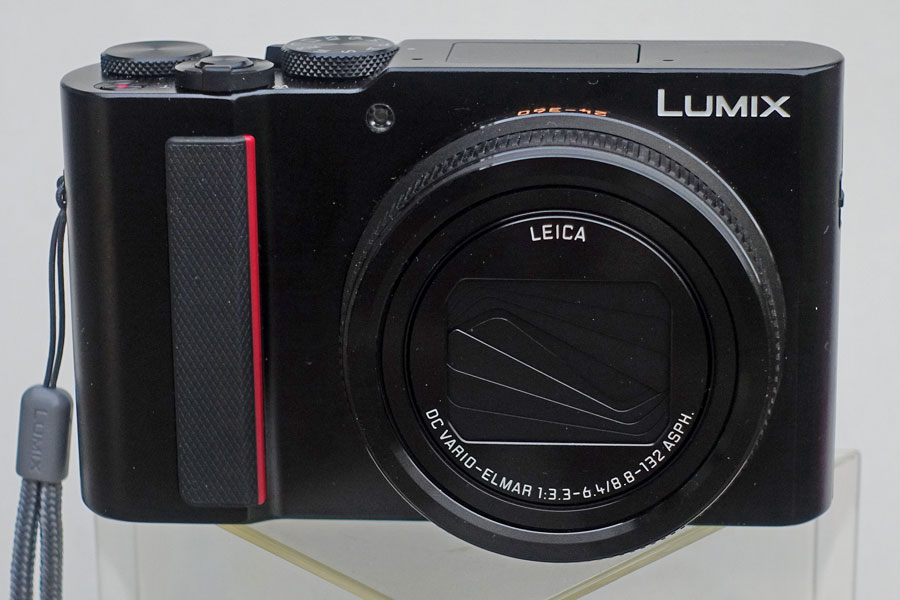 |
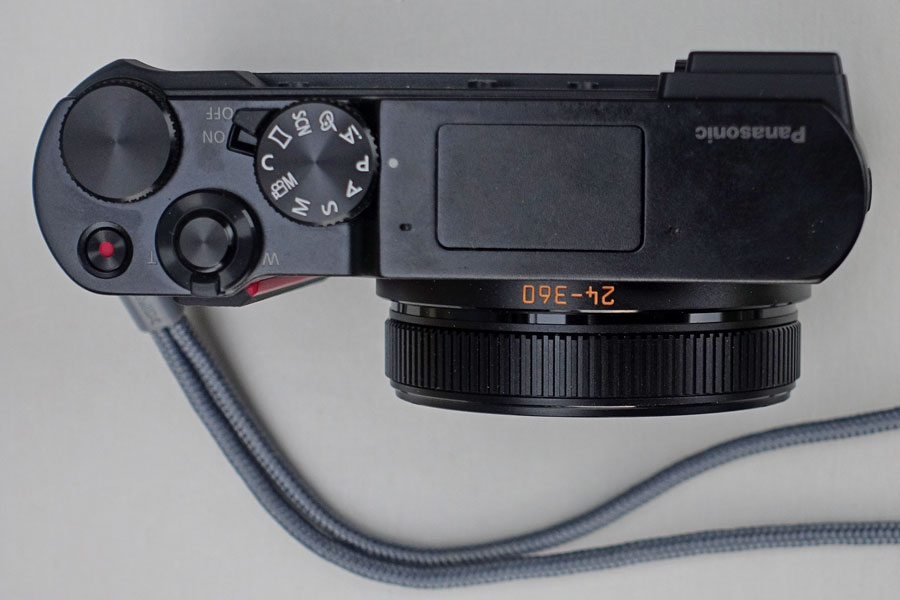 |
|
Front view |
Top view, off |
|
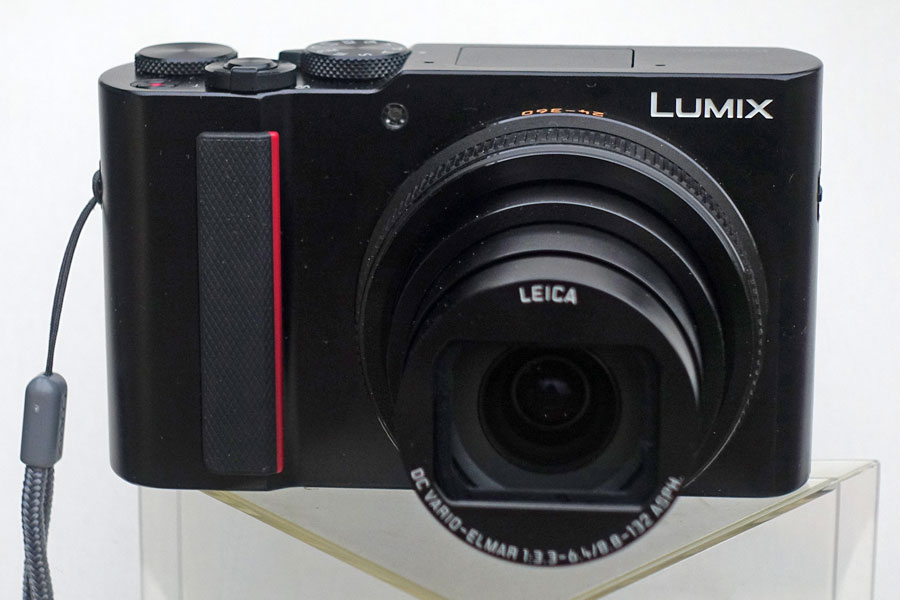 |
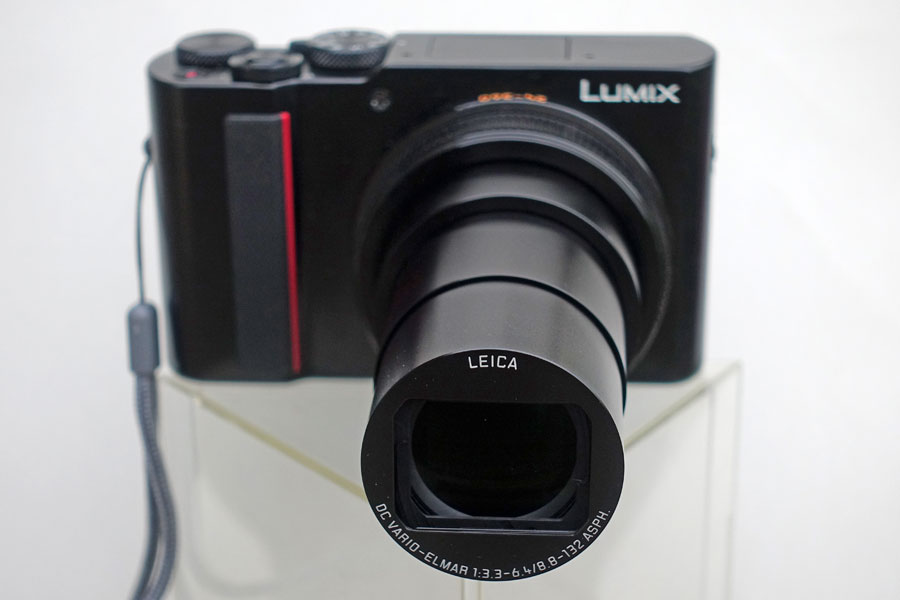 |
|
Front view, on, wide angle |
Front view, on, telephoto |
|
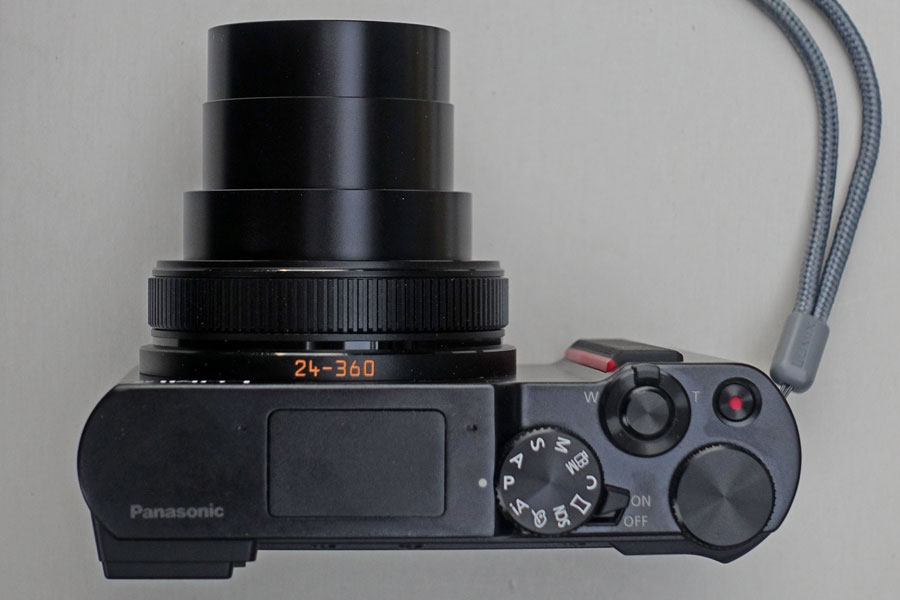 |
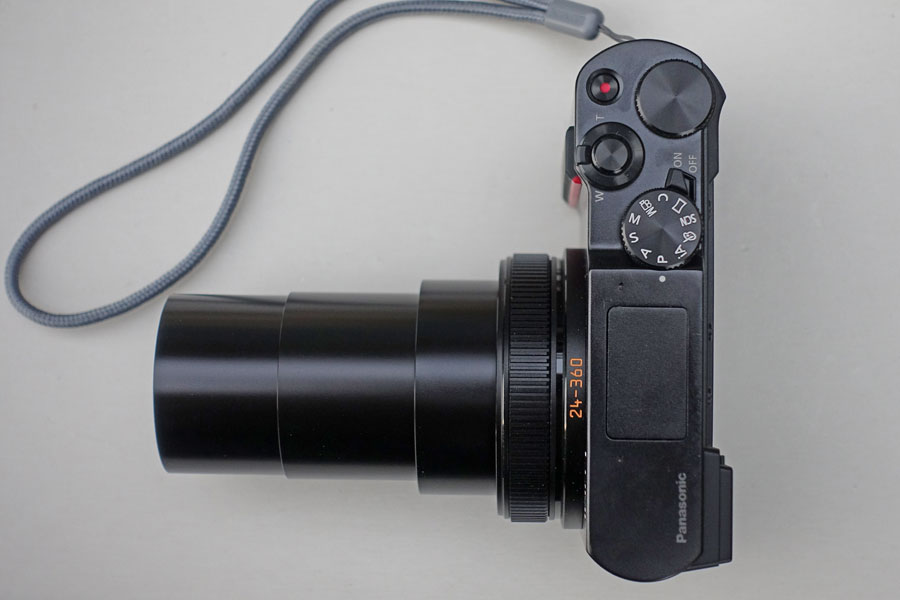 |
|
Top view, on, wide angle |
Top view, on, telephoto |
|
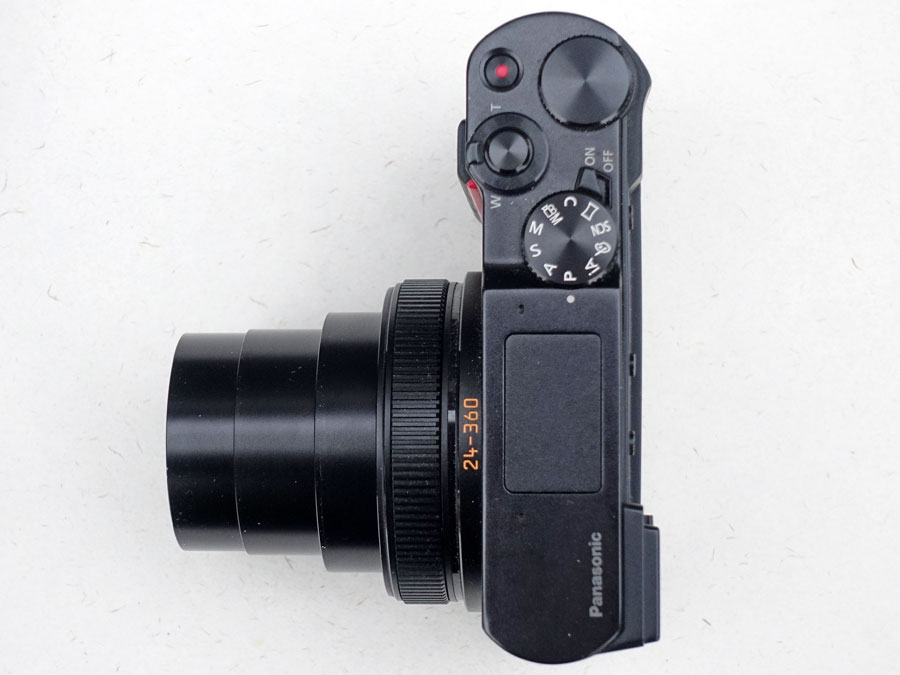 |
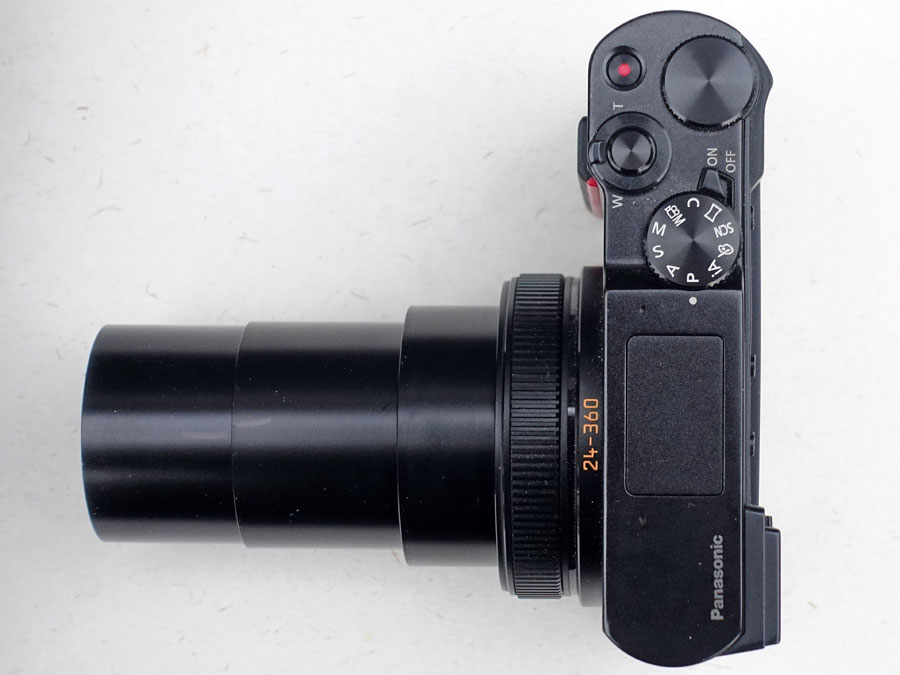 |
|
Top view, on, wide angle |
Top view, on, telephoto |
Photo: The Panasonic TZ202 and its lens
The lens does not have a filter thread for attaching filters or close-up lenses.
Find more technical information about the lens below.
In-Camera Correction of Lens Deficits
All lens designs are a compromise between different requirements and therefore have certain deficits - the PanasonicTZ202's lens is no exception to this rule. Therefore, the lens's deficits are corrected in software for JPG images, but not for RAW images.
A Few Technical Data
| Data | Panasonic TZ202 | Comment |
| Lens | Leica DC Vario-Elmar 8.8-132 mm (24-360 mm equiv.) f/3.3-f/6.4 13 elements in 11 groups |
|
| Zoom | Optical Zoom:15 x Intelligent Zoom: up to 2 x (= 30 x) Digital Zoom: up to 4x (= 60 x) |
There are two types of digital zoom: Intelligent Zoom (higher quality, lower range), and Digital Zoom (lower quality, wider range) - to be refined |
| Filter diameter | None | No possibility for attaching adapters... |
| Aperture range | From f/3.3 to f/8 (wide angle) / f/6.4 to f/8 (telephoto) | Maximum aperture depends on focal length. |
| Distance setting range | AF (W: 50 cm to Infinity, T: 1 m to Infinity) AF Macro (W: 3 cm to Infinity, T: 1 m to Infinity) |
|
| Smallest object field | 56 x 37 / 50 x 33 mm at maximum wide angle (24/28 mm) => 0.236 = 1:4.24; 109 x 73 mm at the telephoto end (360 mm) | My own measurements |
Maximum Aperture Versus Focal Length
This is what I found out:
Focal Length (mm) |
||||||||||||
| Equivalent | 24 |
28 |
35 |
50 |
70 |
90 |
135 |
160 |
200 |
250 |
300 |
360 |
| Actual | 8.8 |
33 |
132 |
|||||||||
| Maximum f-stop* | 3.3 |
3.5 |
3.7 |
4.2 |
4.7 |
5.0 |
5.7 |
5.8 |
6.1 |
6.3 |
6.4 |
6.4 |
*) As indicated by the camera
Smallest Object Field (Minimum object Width)
These are my own coarse measurements on this topic:
|
Focal Length (mm, equiv.)
|
||||||||||||
24 |
28 |
35 |
50 |
70 |
90 |
135 |
160 |
200 |
250 |
300 |
360 |
|
| Min. Distance normal (m)* | 0.5 |
0.5 |
0.5 |
0.5 |
0.5 |
0.5 |
0.5 |
0.5 |
0.7 |
1.0 |
1.0 |
1.0 |
| Min. Distance macro (m)* | 0.03 |
0.03 |
0.05 |
0.1 |
0.2 |
0.3 |
0.5 |
0.5 |
0.7 |
1.0 |
1.0 |
1.0 |
| Min. Object Size macro (mm) | 55-56 |
49-50 |
59-60 |
76-77 |
96-97 |
112-113 |
123-124 |
110-114 |
123-125 |
140 |
123 |
110 |
| Largest Aperture (... f/8)* | 3.3 |
3.5 |
3.7 |
4.2 |
4.7 |
5.0 |
5.7 |
5.8 |
6.1 |
6.3 |
6.4 |
6.4 |
*) As given by the camera, minimum distances not measured
The TZ202 lens has its "sweet spots" at 28 mm, 160 mm, and 360 mm (at 360 mm with nearly the same magnification as at 160 mm). The minimum width filling a frame that the TZ202 can achieve are about 5 cm at 28 mm; at 160 and 360 mm, minimum object width decreases to 11 cm.
Close-Up Samples - "Sweet Spots"
The following close-up sample demonstrate the "sweet spots" of the lens for taking optimal close-ups (the maximum width of the butterfly Hamadryas belladonna is about 6.8 cm):
 |
 |
|
24 mm* (5.5-5.6 cm) |
28 mm (4.9-5.0 cm) |
|
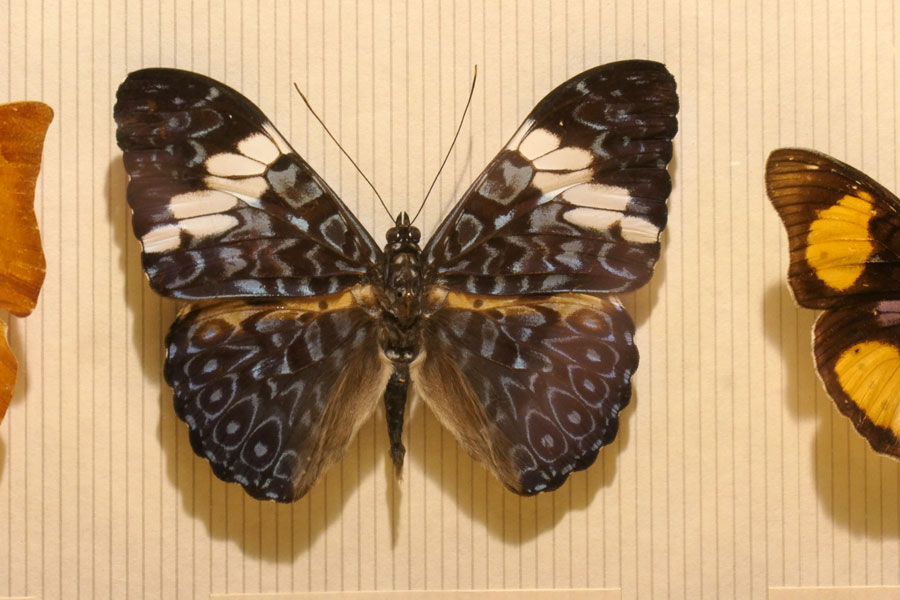 |
 |
|
160 mm (11.0-11.4 cm; approx.50 cm) |
360 mm (11.0 cm; approx. 100 cm) |
|
 |
 |
|
720 mm, i.Zoom (digital zoom; 5.5 cm; approx. 100 cm) |
Ditto, for comparison purposes |
Sharpness Data
See the Lens Reviews below.
Some Quotations from Lens Reviews
In the following, I cite a few sections about the lens of the Panasonic TZ200/202 from reviews that I found on the Internet. This selection is, of course arbitrary, but may help readers gain a certain "feeling" for the lens. Many reviewers that are not cited here bemoan that the lens is rather slow. At the long end, the lens starts at f/6.4 and already ends at f/8 which leaves little choice and is already affected by diffraction. Some reviewers are thus, not sure whether the additional zoom range (and slower speed), compared with the predecessor TZ100/101, is worth it.
dpreview.com
In the review of the Panasonic TZ200/202 on dpreview.com, the authors wrote the following as "key takeaways" about the lens:
- The lens on our first ZS200 was very soft in the center. We tried two other cameras which had their own optical problems.
- This softness isn't entirely surprising, since it's a long zoom that takes up very little space, and diffraction from small equivalent apertures makes things even softer.
They summarized their results as follows:
- First things first: The lens on our ZS200 is very soft, especially in the center of the frame. We tried another ZS200 and it was better in the center but was worse on the left side. The third camera was tried was even worse than the first. Your experience may vary.
- It is worth pointing out that some softness on a compact, 15X zoom lens is to be expected. The effects of diffraction due to the small equivalent apertures (which crosses F10 equiv. at 35mm) just amplifies the softness. The camera's JPEG engine does do a fairly good job at compensating for this softness, and we expect that many ZS200 owners won't be bothered by it. The camera does offer a 'diffraction correction' mode, which adds additional sharpening at smaller apertures.
For details of the lens' performance at various ISO values and in comparison to other cameras, you can have a look at the studio scene on the same page.
All in all, this review probably did not give the TZ200/202 sales a boost. In discussion forums, the camera was more or less "out" afterwards. It must, however, be noted that there were and still are users who are quite content with the lens' performance*, and I would add myself to this list. At Christmas 2018, the price had dropped from 800 EUR to about 650 EUR in Germany...
*) My gripes refer more to the camera's processing (which is regarded as good in this review)...
digitalkamera.de (Free and Pay Content)
The German photography Website digitalkamera.de published a test of the Panasonic TZ202 (in German, performed with DxOMark software). Here is an excerpt of the result for the lens (too long for translation...):
- Objektive mit großem Brennweitenbereich leiden recht häufig unter Farbsäumen, sichtbaren Randabdunklungen und Verzeichnungen. Diese fallen bei der Kamera sehr gering aus, was vermutlich an der internen elektronischen Korrektur liegt. Die Schärfe ist, bezogen auf einen 20 x 30 cm Ausdruck, in allen Brennweiten und Blendeneinstellungen – bei denen es maximal bis F8 geht – vollkommen ausreichend, zeigen aber eine Tendenz zur Überschärfung.
- Das Objektiv der TZ202 zeigt eine maximale Auflösung bei F3,3 und 24 mm Brennweite von etwas mehr als 52 Linienpaaren pro Millimeter (lp/mm) und bei gleicher Blende von 25 lp/mm am Bildrand. Wird die Blende geschlossen, erhöht sich zwar die Auflösung am Bildrand, dafür verringert sich diese in der Bildmitte. Bei maximaler Brennweite reduziert sich die Auflösung auf 36 lp/mm in der Bildmitte und 22,2 lp/mm am Bildrand. Damit liegt sie oberhalb der Ergebnisse der TZ101, obwohl die TZ202 eine größere Brennweite besitzt.
The lp/mm values have been scaled to 35 mm values, but I do not quite understand what this means.
They also published a thorough technical lab test of the Panasonic TZ202 (in German), which can be downloaded for a fee from this page. Since this is pay content, I cannot report on this test here.
Trusted Reviews
Andy Westlake from Trusted Reviews wrote the following about the TZ200/202's lens:
- The TZ200's headline feature is its 24-360mm lens, which is easily the longest on any pocket camera with a 1in sensor. Its extended reach has been made possible by the adoption of a completely new 13-element, 11-group optical design, and brings the TZ200 somewhat closer to the zoom ranges offered by cheaper long-zoom compacts with smaller sensors and inferior image quality.
- In return, the maximum aperture has dropped, but only by about half a stop to f/3.3-6.4 (from f/2.8-5.9). The minimum aperture at all focal lengths is f/8, which is perfectly sensible to avoid excessive diffraction softening with a 1in sensor. However, this means you have precious little adjustment range at the long end of the zoom.
- Naturally, optical image stabilisation is built-in, which goes a long way towards making this small-aperture superzoom usable without always having to raise the ISO to avoid blur form camera-shake. To further cement the camera's credentials as an all-rounder, the lens is capable of focusing on subjects just 3cm from the front element, although only when it's set to the wide-angle position.
Resolution
- Panasonic's JPEG processing aims to eliminate any image-sampling artefacts, resulting in little more than 3000 lines per picture height at ISO 125. Looking at processed raw reveals the reason, with considerable false-colour and aliasing appearing at frequencies finer than 3200 l/ph, betraying the lack of an optical low-pass filter.
- These effects are swamped by noise at ISO 800, where the resolution drops below 3000 l/ph. At higher settings it decreases monotonously. Our tests were shot at the lens' sweet spot, around 50mm equivalent and f/4.4. At longer settings and smaller apertures you'll see lower resolution.
Photography Blog
Tim Coleman from Photography Blog wrote the following about the TZ200/202's lens:
- Really, the big point of interest here is the new lens. It's a 15x optical zoom lens made up of 13 elements in 11 groups, with a 24-360mm equivalent focal length range. That's up from the 10x zoom range of the TZ100, which features a 25-250mm lens. No other compact camera with 1in sensor comes close to the Panasonic TZ200.
- That wider zoom range does come at a cost - the maximum aperture is a little slower in the TZ200, being f/3.3-6.4 compared to f/2.8-5.9. The minimum aperture is f/8 at any focal length.
- Truly, it's quite the feat to cram in such a long reaching zoom lens into a compact camera with 1in imaging sensor. What's more, the macro focusing has also been improved, down from a minimum of 5cm to 3cm. Again, for a camera with 1in sensor, that's impressive.
And in the lens section itself, he writes:
- In summary, the reduced maximum aperture (compared to the TZ100) is a compromise for that longer reach of 360mm. You'll know whether or not that extra reach will make all the difference to you, but for this reviewer the 10x optical zoom of the TZ100 is sufficient.
- And what of sharpness in the corners of the frame? A complex lens like this has its work cut out to achieve sharp detail from the centre all the way to the edges. Sadly, corner softness is evident in the TZ200, though it is not anything out of the norm. We would expect to see this kind of softness in other similar cameras too. It's just the corner detail of the TZ200 is sufficient rather than jaw dropping.
- So to summarise this section, we'd say the lens performs best at its wider half and with the aperture as close to f/4 as possible.
In the summary, he writes about the lens:
- In reality, we are not sure how much that extra reach of the lens is worth it. There is a slight pay-off for that extended maximum focal length of 360mm, in the shape of a reduced maximum aperture. Given how image quality drops at f/6.3 and beyond, it is not possible to get the most out of the extended telephoto settings.
- When used in its wide to mid-telephoto settings, image quality is excellent.
Richard Wong
In his review of the TZ200, Richard Wong writes about image Sharpness (with many sample and comparison photos on his site):
- For a compact high power zoom lens camera, the centre sharpness is pretty decent throughout the whole focal length range. Sharpest photos are around 100mm focal length but even at the extreme wide angle and telephoto end the sharpness is still quite decent.
- When we look at the corners, we can see some of the limitations of this 15x zoom lens. At the widest focal length, the corners are quite soft at maximum aperture. Fortunately stopping down help improves the sharpness quite a bit. When you zoom in a bit to around 50mm then the corner sharpness starting to improve. Again, around 100mm seems to be the sweet spot for this lens but the sharpness remains decent when you zoom all the way to 360mm.
My Own Two Cents...
Actually, the Panasonic TZ202 was the first camera, where I did not check the corners and the overall lens quality. So, my opinion is not really grounded in data... First of all, I wanted a compact 1" camera with a long zoom range for shooting bugs and flowers from a distance, and this was and still is the one with the longest range for a compact 1" camera that you can get. I considered the Panasonic TZ100/101 a year ago or so, but its lens quality was not at all praised, and the viewfinder was regarded as poor. So I bought a Sony RX100 M4 instead... When the first reviews of the TZ202 appeared, the lens was also not really "praised", particularly its performance at the long end (it was often called "soft"), but most reviewers found a minor improvement in lens quality. In addition, the for me important EVF was improved. So, after I had read the reviews on digitalkamera.de and Chasseur d'Image, I decided that I switch to the Panasonic TZ202 - and to a whole new universe with respect to camera handling. And then the devastating review on dpreview.com was published! Would I have bought the TZ202 after that review? I think, probably not. In the end, I was not shocked to death by this review, because it looked to me as if I had received one of the rare(?) better samples. And there were and still are people in discussion forums who maintain that their TZ200/202 delivers satisfying results. I would second that.
All in all, it is not so much the lens, but the JPG image processing that I find the weak point of the camera, particularly if I compare the TZ202 with our Sony 1" sensor cameras. I was experimenting with image settings for quite a while and, like many others, changed the default values and reduced the noise reduction in particular. But I am still not there, where the Sony cameras are... But I should also mention that after I had got accustomed to the "working" of the TZ202 (which took quite a while and involved buying a book about the camera), I was quite pleased with using it - and my wife as well when she used it for a day on vacation.
At the end of 2018, however, I decided with a heavy heart to part with the Panasonic TZ202 and to buy a "monster" called Sony RX10 M3. Read more on the decision process on page Introduction.
References
The following online reviews of the Panasonic TZ202 typically include a review of the lens:
- Panasonic Lumix DC-ZS200/TZ200 Review (Jeff Keller & Dan Bracaglia &, dpreview.com): www.dpreview.com/reviews/panasonic-lumix-dmc-zs200-tz200
- Panasonic TZ200 review (Andy Westlake, Trusted Reviews): www.trustedreviews.com/reviews/panasonic-tz200
- Panasonic Lumix TZ200 Review (Tim Coleman, Photography Blog): www.photographyblog.com/reviews/panasonic_lumix_dmc_tz200_review
- Panasonic Lumix TZ200 (ZS200) Full Review (ePHOTOzine): www.ephotozine.com/article/panasonic-lumix-tz200--zs200--full-review-31930
- Panasonic Lumix TZ200 ZS200 review (Ken McMahon, Cameralabs): www.cameralabs.com/panasonic-lumix-tz200-zs200-review
- Panasonic Lumix TZ200 review (Amy Davies, Stuff): www.stuff.tv/panasonic/lumix-tz200/review
- Panasonic TZ200 / ZS200 Review (Jeff Meyer, Camera Jabber): camerajabber.com/panasonic-tz200-review
- Panasonic Lumix ZS200 / TZ200 review (Phil Hall, TechRadar): www.techradar.com/reviews/panasonic-lumix-zs200-tz200
- Panasonic Lumix DC-TZ220 / TZ200 / ZS200 / TX2 Review (Richard Wong): www.photobyrichard.com/reviewbyrichard/panasonic-lumix-dc-tz220-tz200-zs200-tx2-review
- TEST / APN compact Panasonic Lumix TZ200 : un bon compagnon de voyage (Pascale Brites, Les Numeriques): www.lesnumeriques.com/appareil-photo-numerique/panasonic-lumix-tz200-p43145/test.html
- Panasonic LUMIX TZ200 | Hands-On First Look (Matt Higgs, Wex Photo Video): www.wexphotovideo.com/blog/news/panasonic-tz200--hands-on-first-look/
- Testbericht: Panasonic Lumix DC-TZ202 (digitalkamera.de): www.digitalkamera.de/Testbericht/Testbericht_Panasonic_Lumix_DC-TZ202/10816.aspx (in German)
| 11.02.2019 |